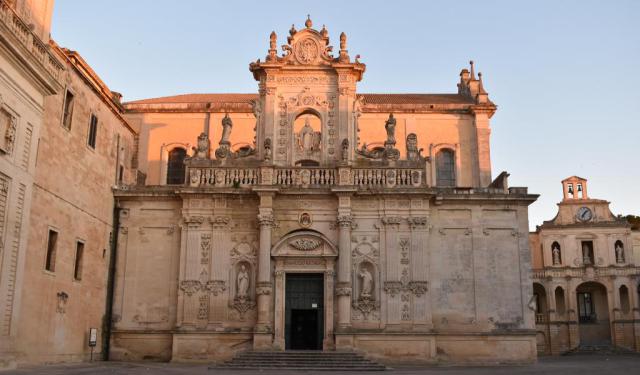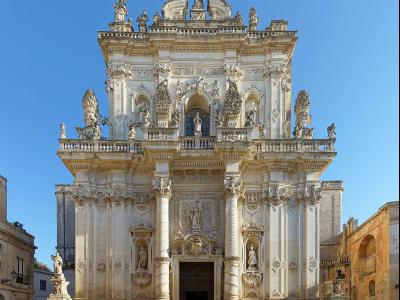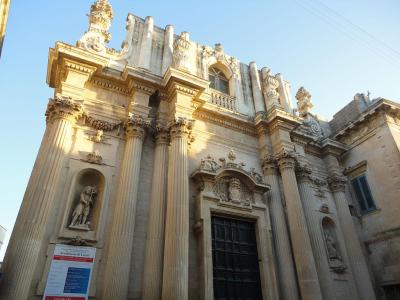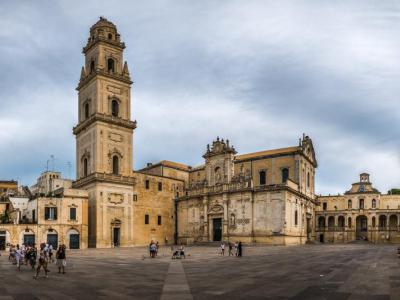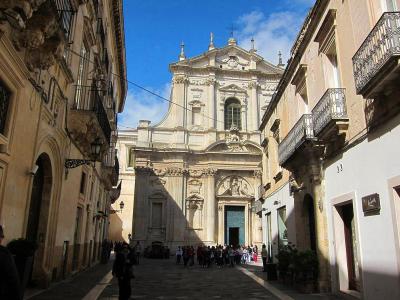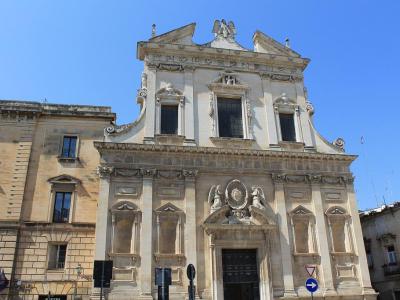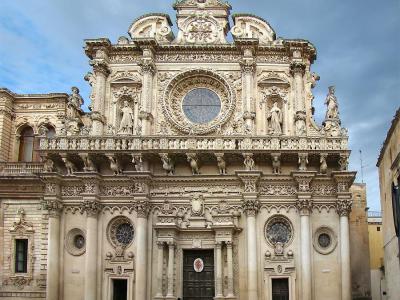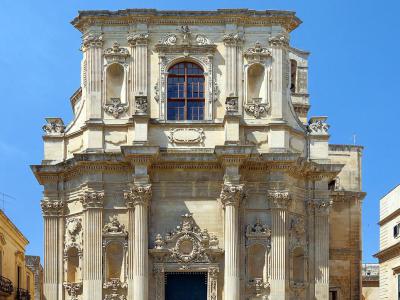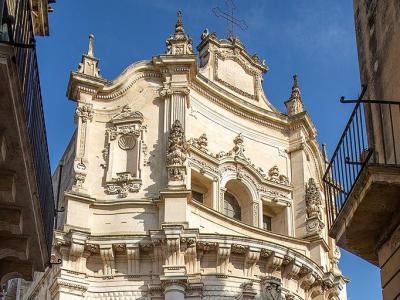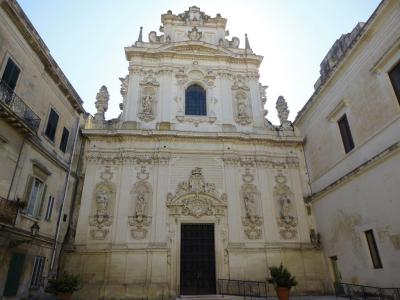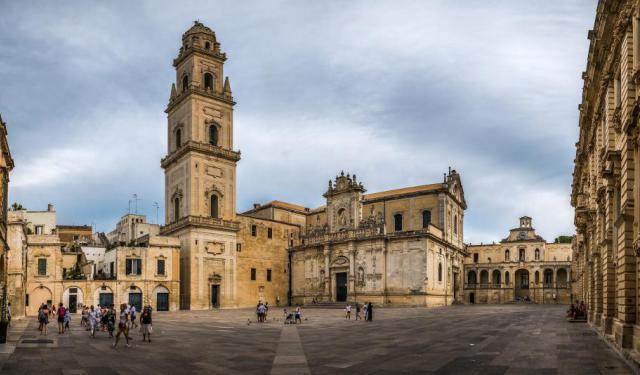Lecce's Baroque Churches Walking Tour (Self Guided), Lecce
Lecce isn’t shy about its reputation-it’s often called the “Capital of Baroque,” and one stroll through the old town makes it clear why. This southern Italian city turned its soft local limestone, Lecce stone, into an architect’s playground. Elaborate façades, swirling details, and sculptures bursting from the walls made the 17th century feel like one long design competition. And with 22 churches packed into the historic center alone, Lecce didn’t just dabble in Baroque-it went all in.
It feels right to put the Cathedral Square as a checkpoint, a square that feels like a stage set. Here stands the Lecce Cathedral, flanked by its slender bell tower. At sunset, the whole space glows in golden stone, making it one of Italy’s most dramatic urban backdrops. A short walk brings you to the Basilica of the Holy Cross, where Baroque runs riot-stone animals, swirling motifs, and a rose window designed to stop you in your tracks.
But Lecce’s flair isn’t limited to the headline acts. The Church of Jesus packs geometric precision outside and high drama inside. The Church of Saint Irene, once the city’s patron, offers soaring chapels and sculpture in spades. Saint Chiara's Church calms things down with an oval interior bathed in soft light, while Saint Matthew's Church breaks the rules with a wavy façade that seems to shift as you move.
The Carmine Church shows off how stone here can look as delicate as lace, and the Church of Saint Theresa stands out for its restraint-Baroque with its volume turned just a notch lower. Finally, the Church of Saint John the Baptist of the Rosary closes the list with a stately façade and a richly ornamented interior that lives up to its name.
Scholars call this “architectural embroidery,” but you don’t need an art degree to get it-just look at how light and shadow dance across the carvings. Lecce’s churches are less about quiet devotion and more about theater in stone, each one demanding your gaze.
So wander the streets, step inside when the doors are open, and let Lecce’s Baroque storytellers do their work.
It feels right to put the Cathedral Square as a checkpoint, a square that feels like a stage set. Here stands the Lecce Cathedral, flanked by its slender bell tower. At sunset, the whole space glows in golden stone, making it one of Italy’s most dramatic urban backdrops. A short walk brings you to the Basilica of the Holy Cross, where Baroque runs riot-stone animals, swirling motifs, and a rose window designed to stop you in your tracks.
But Lecce’s flair isn’t limited to the headline acts. The Church of Jesus packs geometric precision outside and high drama inside. The Church of Saint Irene, once the city’s patron, offers soaring chapels and sculpture in spades. Saint Chiara's Church calms things down with an oval interior bathed in soft light, while Saint Matthew's Church breaks the rules with a wavy façade that seems to shift as you move.
The Carmine Church shows off how stone here can look as delicate as lace, and the Church of Saint Theresa stands out for its restraint-Baroque with its volume turned just a notch lower. Finally, the Church of Saint John the Baptist of the Rosary closes the list with a stately façade and a richly ornamented interior that lives up to its name.
Scholars call this “architectural embroidery,” but you don’t need an art degree to get it-just look at how light and shadow dance across the carvings. Lecce’s churches are less about quiet devotion and more about theater in stone, each one demanding your gaze.
So wander the streets, step inside when the doors are open, and let Lecce’s Baroque storytellers do their work.
How it works: Download the app "GPSmyCity: Walks in 1K+ Cities" from Apple App Store or Google Play Store to your mobile phone or tablet. The app turns your mobile device into a personal tour guide and its built-in GPS navigation functions guide you from one tour stop to next. The app works offline, so no data plan is needed when traveling abroad.
Lecce's Baroque Churches Walking Tour Map
Guide Name: Lecce's Baroque Churches Walking Tour
Guide Location: Italy » Lecce (See other walking tours in Lecce)
Guide Type: Self-guided Walking Tour (Sightseeing)
# of Attractions: 9
Tour Duration: 1 Hour(s)
Travel Distance: 2.0 Km or 1.2 Miles
Author: DanaOffice
Sight(s) Featured in This Guide:
Guide Location: Italy » Lecce (See other walking tours in Lecce)
Guide Type: Self-guided Walking Tour (Sightseeing)
# of Attractions: 9
Tour Duration: 1 Hour(s)
Travel Distance: 2.0 Km or 1.2 Miles
Author: DanaOffice
Sight(s) Featured in This Guide:
- Basilica di San Giovanni Battista al Rosario (Church of Saint John Battista of Rosario)
- Chiesa di Santa Teresa (Church of Saint Theresa)
- Lecce Cathedral and Square
- Chiesa di Sant'Irene (Saint Irene Church)
- Chiesa del Gesu (Church of Jesus)
- Basilica di Santa Croce (Basilica of the Holy Cross)
- Chiesa di Santa Chiara (Saint Chiara Church)
- Chiesa di San Matteo (Church of Saint Mathew)
- Chiesa del Carmine (Carmine Church)
1) Basilica di San Giovanni Battista al Rosario (Church of Saint John Battista of Rosario)
The Church of Saint John the Baptist of the Rosary isn’t shy about showing off its Baroque credentials. This church has anchored its parish since 1914, but its story stretches back much further. The Dominicans first landed here in 1388, and by the late 1600s, they decided the old building just wasn’t cutting it. Cue master architect Giuseppe Zimbalo, the man behind much of Lecce’s Baroque look. At seventy years old, he launched the project in 1691, even helping to fund it himself. By the time of his death in 1710, the walls were up, but finishing touches fell to other local talents, who wrapped it up in 1728.
From the outside, the façade is pure Baroque theater. The lower part of the church greets you with two tall, decorated columns framing an entrance dramatic enough to deserve its own soundtrack. Above the doorway sits the Dominican crest, crowned by a statue of Saint Domenico di Guzmán, the order’s founder. Get a bit closer and you’ll notice two more stone figures-Saint John the Baptist and Blessed Francis-like a carved lineup of the church’s VIPs.
Inside, the layout trades the drama for harmony. The church follows a Greek cross plan, its spacious octagonal chamber capped with wooden trusses. Along the edges, twelve side chapels hold richly carved Baroque altars-miniature showcases of Lecce stonework, each competing to outshine the next.
This basilica may not be Lecce’s loudest Baroque statement, but it’s a masterclass in elegance and devotion-a place where Zimbalo’s vision and his successors’ craft come together in perfect balance.
From the outside, the façade is pure Baroque theater. The lower part of the church greets you with two tall, decorated columns framing an entrance dramatic enough to deserve its own soundtrack. Above the doorway sits the Dominican crest, crowned by a statue of Saint Domenico di Guzmán, the order’s founder. Get a bit closer and you’ll notice two more stone figures-Saint John the Baptist and Blessed Francis-like a carved lineup of the church’s VIPs.
Inside, the layout trades the drama for harmony. The church follows a Greek cross plan, its spacious octagonal chamber capped with wooden trusses. Along the edges, twelve side chapels hold richly carved Baroque altars-miniature showcases of Lecce stonework, each competing to outshine the next.
This basilica may not be Lecce’s loudest Baroque statement, but it’s a masterclass in elegance and devotion-a place where Zimbalo’s vision and his successors’ craft come together in perfect balance.
2) Chiesa di Santa Teresa (Church of Saint Theresa)
The Church of Saint Theresa is Baroque Lecce at its most thoughtful-less fireworks than some of its neighbors, but no less impressive. Built in 1620 for the Discalced Carmelites (Catholic Order who devotes their life to prayer), it was designed by Giuseppe Zimbalo, Lecce’s master architect known for turning soft limestone into elaborate Baroque decoration. By 1630, the church and its adjoining convent were complete, rising on the site of two older chapels.
Time hasn’t always been kind. By the 19th century the place was showing its age, until a major restoration in 1831. That effort gave the building back its dignity and kept Zimbalo’s vision from slipping into ruin.
The façade is where things get interesting. Technically unfinished, it still delivers plenty of drama. Two stacked levels draw your eye upward, starting with Corinthian columns and playful carved garlands on the lower section. Look closely and you’ll spot stone statues of Saint John the Baptist and Saint John the Evangelist standing in the niches like silent greeters.
The upper level never got its crowning pediment, but you won’t miss it-what’s there is enough. A large window framed by delicate floral motifs keeps the balance, echoing details from the nearby Church of the Rosary.
So while Saint Theresa’s church may not flaunt the over-the-top theatrics of the Church of the Holy Cross, it’s a perfect example of Lecce Baroque playing it cool: richly detailed where it matters, dignified even in its unfinished state, and full of quiet character for anyone willing to linger and look.
Time hasn’t always been kind. By the 19th century the place was showing its age, until a major restoration in 1831. That effort gave the building back its dignity and kept Zimbalo’s vision from slipping into ruin.
The façade is where things get interesting. Technically unfinished, it still delivers plenty of drama. Two stacked levels draw your eye upward, starting with Corinthian columns and playful carved garlands on the lower section. Look closely and you’ll spot stone statues of Saint John the Baptist and Saint John the Evangelist standing in the niches like silent greeters.
The upper level never got its crowning pediment, but you won’t miss it-what’s there is enough. A large window framed by delicate floral motifs keeps the balance, echoing details from the nearby Church of the Rosary.
So while Saint Theresa’s church may not flaunt the over-the-top theatrics of the Church of the Holy Cross, it’s a perfect example of Lecce Baroque playing it cool: richly detailed where it matters, dignified even in its unfinished state, and full of quiet character for anyone willing to linger and look.
3) Lecce Cathedral and Square (must see)
A step into Cathedral Square reveals Lecce’s secret garden of carved stone and Baroque bravado-hidden behind a slim passage off Libertini Street. Here, the Cathedral of the Assumption presides like a diva atop a set of cascading stairs, flanked by stout columns that guard niches boasting statues of Saints Giusto and Fortunato. Legend says Saint Orontius himself watches from his ornate arch above, forever grateful for slaying the plague rather than dragons.
This isn’t your average medieval church: since its inauguration in 1144, Lecce’s Cathedral has had two makeovers-first in 1230, then in 1659 when Giuseppe Zimbalo supercharged it with baroque exuberance. The majesty of the edifice invites anyone to cross the threshold into a world of three naves divided by sculpted pilasters and columns, under a 1685 wooden ceiling painted by Giuseppe da Brindisi. Twelve side chapels brim with altars honoring everyone from sacrament superstars to the lives of Jesus and Mary.
Guarding the square’s flanks are three other grand players: the Bishop’s Palace, which got its stately clock and facade facelift in 1758; the soaring 230-foot bell tower, another Zimbalo marvel from 1682; and the Seminary, Giuseppe Cino’s 1729 masterpiece that wraps the west side in Rococo ruffles. Together, they form Lecce’s ultimate architectural girl band-each with its own star turn, yet perfectly in sync.
So pause beneath those sculpted ledges, let your eyes follow the soaring bell tower skyward, and picture the endless parades that once wove through this secret square. In Lecce, even the quietest corner is a stage-and everyone gets front-row seats.
This isn’t your average medieval church: since its inauguration in 1144, Lecce’s Cathedral has had two makeovers-first in 1230, then in 1659 when Giuseppe Zimbalo supercharged it with baroque exuberance. The majesty of the edifice invites anyone to cross the threshold into a world of three naves divided by sculpted pilasters and columns, under a 1685 wooden ceiling painted by Giuseppe da Brindisi. Twelve side chapels brim with altars honoring everyone from sacrament superstars to the lives of Jesus and Mary.
Guarding the square’s flanks are three other grand players: the Bishop’s Palace, which got its stately clock and facade facelift in 1758; the soaring 230-foot bell tower, another Zimbalo marvel from 1682; and the Seminary, Giuseppe Cino’s 1729 masterpiece that wraps the west side in Rococo ruffles. Together, they form Lecce’s ultimate architectural girl band-each with its own star turn, yet perfectly in sync.
So pause beneath those sculpted ledges, let your eyes follow the soaring bell tower skyward, and picture the endless parades that once wove through this secret square. In Lecce, even the quietest corner is a stage-and everyone gets front-row seats.
4) Chiesa di Sant'Irene (Saint Irene Church)
The Church of Saint Irene stands proudly in Lecce’s historic center, dedicated to the city’s onetime protector, Saint Irene of Lecce. She held the title until 1656, when Pope Alexander VII handed the patron saint role over to Saint Oronzo-basically a celestial reshuffle at the top.
Construction started in 1591 under architect Francesco Grimaldi, who had sharpened his skills in Rome, and by 1639 the church was ready to open its doors. The bishop of Brindisi presided over the consecration, sealing its place in Lecce’s spiritual map.
Over the centuries, the church saw its share of drama. In 1797, King Ferdinand IV of Naples stopped by-always a good sign you’ve made it onto the “hot ones” list. Later, in October 1860, Saint Irene’s turned into a civic hotspot when it hosted the plebiscite deciding whether Lecce would join the Kingdom of Italy. Even after the adjoining convent was closed in 1866, the church kept its doors open for worship, showing its staying power.
The architecture is pure Baroque confidence, modeled on Rome’s Saint Andrea della Valle. The façade is a double-decker spectacle: below, columns and decorative flourishes, including niches that once begged for statues; above, a grand window framed by molded wreaths and pilasters. It’s a textbook example of how Lecce used stone like other artists use paint-layered, ornate, and designed to impress.
Saint Irene may have passed the baton as patroness, but her church remains one of Lecce’s great Baroque landmarks, mixing local devotion with architectural talent.
Construction started in 1591 under architect Francesco Grimaldi, who had sharpened his skills in Rome, and by 1639 the church was ready to open its doors. The bishop of Brindisi presided over the consecration, sealing its place in Lecce’s spiritual map.
Over the centuries, the church saw its share of drama. In 1797, King Ferdinand IV of Naples stopped by-always a good sign you’ve made it onto the “hot ones” list. Later, in October 1860, Saint Irene’s turned into a civic hotspot when it hosted the plebiscite deciding whether Lecce would join the Kingdom of Italy. Even after the adjoining convent was closed in 1866, the church kept its doors open for worship, showing its staying power.
The architecture is pure Baroque confidence, modeled on Rome’s Saint Andrea della Valle. The façade is a double-decker spectacle: below, columns and decorative flourishes, including niches that once begged for statues; above, a grand window framed by molded wreaths and pilasters. It’s a textbook example of how Lecce used stone like other artists use paint-layered, ornate, and designed to impress.
Saint Irene may have passed the baton as patroness, but her church remains one of Lecce’s great Baroque landmarks, mixing local devotion with architectural talent.
5) Chiesa del Gesu (Church of Jesus)
The Church of Jesus is situated in the historical center. It served as the headquarters for the Society of Jesus for many centuries. Construction of the church began in 1575 to accommodate the Jesuits who arrived in the city. The religious edifice, designed by Giovanni De Rosis, a Jesuit from Como, opened for worship in 1577.
The architecture of the building was inspired by the Church of Jesus in Rome, which is considered the main church of the Jesuit order. The facade is simple and linear, divided into two sections with volutes connecting them. It features double rows of pilasters interrupted by a projecting entablature.
The interior follows a Latin cross plan with a short transept and four interconnected chapels on each side of the central nave. The wooden coffered ceiling is adorned with canvases depicting the Glories of the Society of Jesus by Giuseppe da Brindisi.
Inside the church, valuable paintings and sculptures are dating from the late 16th century to the early 19th century. The left side of the church contains the altars of Madonna di Loreto with a 17th-century statue of Madonna, San Girolamo with a canvas by painter Girolamo Imparato, San Michele Arcangelo (1746), and the Annunciation with a canvas dating back to 1596.
The presbytery area houses the impressive main altar made of Lecce stone, constructed in 1699 and attributed to sculptor Giuseppe Cino. At the base of the altar, there is an 18th-century walnut wooden choir added by the Benedictines of Montescaglioso, who took over the church after the suppression of the Jesuits.
The architecture of the building was inspired by the Church of Jesus in Rome, which is considered the main church of the Jesuit order. The facade is simple and linear, divided into two sections with volutes connecting them. It features double rows of pilasters interrupted by a projecting entablature.
The interior follows a Latin cross plan with a short transept and four interconnected chapels on each side of the central nave. The wooden coffered ceiling is adorned with canvases depicting the Glories of the Society of Jesus by Giuseppe da Brindisi.
Inside the church, valuable paintings and sculptures are dating from the late 16th century to the early 19th century. The left side of the church contains the altars of Madonna di Loreto with a 17th-century statue of Madonna, San Girolamo with a canvas by painter Girolamo Imparato, San Michele Arcangelo (1746), and the Annunciation with a canvas dating back to 1596.
The presbytery area houses the impressive main altar made of Lecce stone, constructed in 1699 and attributed to sculptor Giuseppe Cino. At the base of the altar, there is an 18th-century walnut wooden choir added by the Benedictines of Montescaglioso, who took over the church after the suppression of the Jesuits.
6) Basilica di Santa Croce (Basilica of the Holy Cross) (must see)
By the 16th century, Lecce’s blueprint for holy real estate was simple: clear out the Jewish neighborhood, lay the stones for a grand church, and call it progress. Back in 1510, the city’s Jews were unceremoniously shown the door-and by 1549, architects and stone masons were on the job, creating a new basilica for the venerable Celestine monastery next door.
The architects in charge took their sweet time, tacking on Baroque flourishes for well over a century. Finally, in 1699, the Basilica of the Holy Cross unveiled its riotously ornate façade: six sleek columns flanking the portal, topped by a frieze bristling with fantastical beasts and exotic foliage. Keep an eye out for the heraldic cameos-Philip III of Spain, Mary of Enghien, Walter VI of Brienne (all kings and queens)-and even the hefty visages of captured Turks propping up the decorative band.
Step inside, and you’ll find a Latin-cross layout with three central aisles (two side lanes now chapels) and a 1590 dome that’s stubbornly resisted every earthquake. Sixteen Baroque altars gleam in the glow-none more show-stopping than the 1615 masterpiece to Saint Francis of Paola, tucked into the left transept like the city’s most precious keepsake. Paintings of shepherds adoring, Mary annunciating, and the flight into Egypt line the walls, while the wooden ceiling-rebuilt in 1800-arches overhead.
In Lecce, even a church tells a century-long story of ambition, artistry, and a dash of architectural one-upmanship.
The architects in charge took their sweet time, tacking on Baroque flourishes for well over a century. Finally, in 1699, the Basilica of the Holy Cross unveiled its riotously ornate façade: six sleek columns flanking the portal, topped by a frieze bristling with fantastical beasts and exotic foliage. Keep an eye out for the heraldic cameos-Philip III of Spain, Mary of Enghien, Walter VI of Brienne (all kings and queens)-and even the hefty visages of captured Turks propping up the decorative band.
Step inside, and you’ll find a Latin-cross layout with three central aisles (two side lanes now chapels) and a 1590 dome that’s stubbornly resisted every earthquake. Sixteen Baroque altars gleam in the glow-none more show-stopping than the 1615 masterpiece to Saint Francis of Paola, tucked into the left transept like the city’s most precious keepsake. Paintings of shepherds adoring, Mary annunciating, and the flight into Egypt line the walls, while the wooden ceiling-rebuilt in 1800-arches overhead.
In Lecce, even a church tells a century-long story of ambition, artistry, and a dash of architectural one-upmanship.
7) Chiesa di Santa Chiara (Saint Chiara Church)
The Church of Santa Chiara sits right in Lecce’s historic center and it’s been drawing eyes since 1429, when Bishop Tommaso Ammirato decided the city needed something special for the Poor Clares (an enclosed Order of nuns). Rolling into the late 1600s, and architect Giuseppe Cino gave it a dramatic Baroque makeover-because in Lecce, stone never stays plain for long.
The façade leans into theater. Its curving shape immediately stands out, and the lower section frames a decorated portal bursting with leafy carvings. Above, a niche held aloft by smiling angels proudly displays the Poor Clares’ coat of arms. The upper level repeats the rhythm with pilasters and niches but ups the drama with a big central window and a scrolling top, like the curtain call of a play.
Step inside and the stage gets bigger. The church’s elongated octagonal plan leads your eyes to a deep presbytery under a starry vaulted ceiling. Along the walls, chapels break up the space, each decorated to impress. The altars go all-in on Baroque flair: twisted columns wrapped with angels, birds, garlands, and scrolls. Wooden statues from the late 1600s stand guard, while niches host saints, creating a full house of heavenly residents.
The true star is the high altar, anchored by twisted columns and crowned with a statue of Saint Clare of Assisi in pride of place. Adding to the richness, you’ll also find a canvas of Saint Agnese by Francesco Solimena, one of the most important painters of the Baroque era, tucked near the altar of Saint Francis of Assisi.
Santa Chiara proves that Baroque wasn’t just about grandeur-it was about joy, energy, and detail so rich it feels alive.
The façade leans into theater. Its curving shape immediately stands out, and the lower section frames a decorated portal bursting with leafy carvings. Above, a niche held aloft by smiling angels proudly displays the Poor Clares’ coat of arms. The upper level repeats the rhythm with pilasters and niches but ups the drama with a big central window and a scrolling top, like the curtain call of a play.
Step inside and the stage gets bigger. The church’s elongated octagonal plan leads your eyes to a deep presbytery under a starry vaulted ceiling. Along the walls, chapels break up the space, each decorated to impress. The altars go all-in on Baroque flair: twisted columns wrapped with angels, birds, garlands, and scrolls. Wooden statues from the late 1600s stand guard, while niches host saints, creating a full house of heavenly residents.
The true star is the high altar, anchored by twisted columns and crowned with a statue of Saint Clare of Assisi in pride of place. Adding to the richness, you’ll also find a canvas of Saint Agnese by Francesco Solimena, one of the most important painters of the Baroque era, tucked near the altar of Saint Francis of Assisi.
Santa Chiara proves that Baroque wasn’t just about grandeur-it was about joy, energy, and detail so rich it feels alive.
8) Chiesa di San Matteo (Church of Saint Mathew)
Imagine stepping into a Baroque time machine and landing in Lecce circa 1700-welcome to the Church of Saint Matthew, brainchild of Achille Larducci di Salo, nephew to Rome’s own star architect Borromini. In 1667, Bishop Luigi Pappacoda ceremoniously plopped down the first stone, replacing a humble 15th-century chapel. By 1700, Larducci’s vision had sprung into glorious reality.
Outside, the façade plays “concave above, convex below” in stunning limestone choreography. The lower register flaunts three sections framed by beefy columns and an ornate main portal crowned with the Franciscan coat of arms. Above, a grand three-part doorway stretches between sculpted columns and niches, all finished with a curving overhang and a tall triangular top that seems to nod hello as you walk by.
Slip inside, and you’ll find a single, sweeping nave traced in an elegant ellipse. Pilasters, each based on a plinth, salute the Twelve Apostles while the left side parades five jeweled altars honoring Saints Agatha, Francis, Rita, the Virgin, and the Pietà. Opposite them stand four more shrines-Madonna of the Light, Saint Anne, the Holy Family, and Saint Orontius-beneath a star-studded vault that feels straight out of a celestial blueprint. In Lecce, even a church floor plan is fit for Baroque stardom-this is Saint Matthew’s grand stage.
Outside, the façade plays “concave above, convex below” in stunning limestone choreography. The lower register flaunts three sections framed by beefy columns and an ornate main portal crowned with the Franciscan coat of arms. Above, a grand three-part doorway stretches between sculpted columns and niches, all finished with a curving overhang and a tall triangular top that seems to nod hello as you walk by.
Slip inside, and you’ll find a single, sweeping nave traced in an elegant ellipse. Pilasters, each based on a plinth, salute the Twelve Apostles while the left side parades five jeweled altars honoring Saints Agatha, Francis, Rita, the Virgin, and the Pietà. Opposite them stand four more shrines-Madonna of the Light, Saint Anne, the Holy Family, and Saint Orontius-beneath a star-studded vault that feels straight out of a celestial blueprint. In Lecce, even a church floor plan is fit for Baroque stardom-this is Saint Matthew’s grand stage.
9) Chiesa del Carmine (Carmine Church)
Walk down Lecce’s historic streets and the Carmine Church almost feels like it’s waiting to tell you a story. Its roots go back to the Carmelites (Catholic Order), who first settled in the city in 1481. When an earthquake in 1546 forced them to move, they rebuilt on the site of the old Church of Saint Nicholas, laying the foundation for what would become one of Lecce’s Baroque highlights.
Construction kicked off in 1711 and wrapped up in 1737, with Giuseppe Cino, Lecce’s go-to architect, shaping the façade. Picture it like a three-tiered stage: statues, windows, and ornate details stacked in perfect balance. Curves play against cross-shaped lines, making the whole design feel both disciplined and playful-stone that seems to breathe with movement.
Inside, the artistry goes up another notch. Between 1731 and 1737, the altars got born, which feature vivid paintings of the Annunciation, Saint Elmo, and the Visitation of the Virgin. With their twisted columns, sculpted figures, and colorful canvases, they capture the drama and devotion of the Baroque at its peak.
The Carmine Church isn’t just another stop on the map-it’s proof that Lecce never did anything halfway when it came to stone and spirit.
Construction kicked off in 1711 and wrapped up in 1737, with Giuseppe Cino, Lecce’s go-to architect, shaping the façade. Picture it like a three-tiered stage: statues, windows, and ornate details stacked in perfect balance. Curves play against cross-shaped lines, making the whole design feel both disciplined and playful-stone that seems to breathe with movement.
Inside, the artistry goes up another notch. Between 1731 and 1737, the altars got born, which feature vivid paintings of the Annunciation, Saint Elmo, and the Visitation of the Virgin. With their twisted columns, sculpted figures, and colorful canvases, they capture the drama and devotion of the Baroque at its peak.
The Carmine Church isn’t just another stop on the map-it’s proof that Lecce never did anything halfway when it came to stone and spirit.
Walking Tours in Lecce, Italy
Create Your Own Walk in Lecce
Creating your own self-guided walk in Lecce is easy and fun. Choose the city attractions that you want to see and a walk route map will be created just for you. You can even set your hotel as the start point of the walk.
Lecce Introduction Walking Tour
German historian Ferdinand Gregorovius called Lecce “the Florence of the Baroque era.” The city traces its beginnings around the time of the Trojan Wars, which took place around the 11th century BC. However, it first steps firmly into the record in the 3rd century BC as Lupiae under Roman control. The name is thought to come from lupus, the Latin word for wolf, recalling the animals that once... view more
Tour Duration: 2 Hour(s)
Travel Distance: 2.1 Km or 1.3 Miles
Tour Duration: 2 Hour(s)
Travel Distance: 2.1 Km or 1.3 Miles
The Most Popular Cities
/ view all
